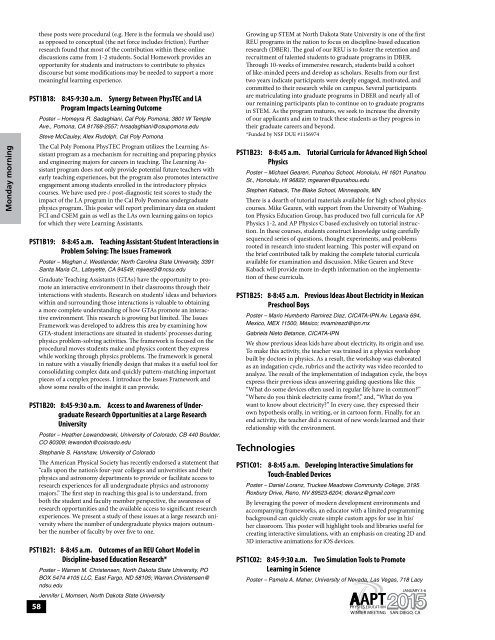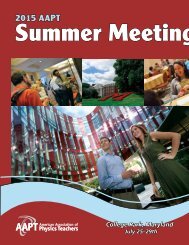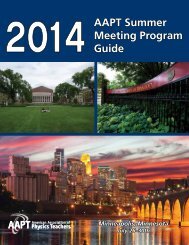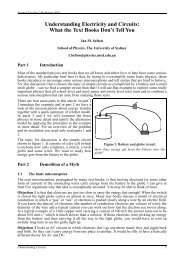final-program-12-23-14-3
final-program-12-23-14-3
final-program-12-23-14-3
Create successful ePaper yourself
Turn your PDF publications into a flip-book with our unique Google optimized e-Paper software.
Monday morning<br />
58<br />
these posts were procedural (e.g. Here is the formula we should use)<br />
as opposed to conceptual (the net force includes friction). Further<br />
research found that most of the contribution within these online<br />
discussions came from 1-2 students. Social Homework provides an<br />
opportunity for students and instructors to contribute to physics<br />
discourse but some modifications may be needed to support a more<br />
meaningful learning experience.<br />
PST1B18: 8:45-9:30 a.m. Synergy Between PhysTEC and LA<br />
Program Impacts Learning Outcome<br />
Poster – Homeyra R. Sadaghiani, Cal Poly Pomona, 3801 W Temple<br />
Ave., Pomona, CA 91768-2557; hrsadaghiani@csupomona.edu<br />
Steve McCauley, Alex Rudolph, Cal Poly Pomona<br />
The Cal Poly Pomona PhysTEC Program utilizes the Learning Assistant<br />
<strong>program</strong> as a mechanism for recruiting and preparing physics<br />
and engineering majors for careers in teaching. The Learning Assistant<br />
<strong>program</strong> does not only provide potential future teachers with<br />
early teaching experiences, but the <strong>program</strong> also promotes interactive<br />
engagement among students enrolled in the introductory physics<br />
courses. We have used pre-/ post-diagnostic test scores to study the<br />
impact of the LA <strong>program</strong> in the Cal Poly Pomona undergraduate<br />
physics <strong>program</strong>. This poster will report preliminary data on student<br />
FCI and CSEM gain as well as the LAs own learning gains on topics<br />
for which they were Learning Assistants.<br />
PST1B19: 8-8:45 a.m. Teaching Assistant-Student Interactions in<br />
Problem Solving: The Issues Framework<br />
Poster – Meghan J. Westlander, North Carolina State University, 3391<br />
Santa Maria Ct., Lafayette, CA 94549; mjwest3@ncsu.edu<br />
Graduate Teaching Assistants (GTAs) have the opportunity to promote<br />
an interactive environment in their classrooms through their<br />
interactions with students. Research on students’ ideas and behaviors<br />
within and surrounding those interactions is valuable to obtaining<br />
a more complete understanding of how GTAs promote an interactive<br />
environment. This research is growing but limited. The Issues<br />
Framework was developed to address this area by examining how<br />
GTA-student interactions are situated in students’ processes during<br />
physics problem-solving activities. The framework is focused on the<br />
procedural moves students make and physics content they express<br />
while working through physics problems. The framework is general<br />
in nature with a visually friendly design that makes it a useful tool for<br />
consolidating complex data and quickly pattern-matching important<br />
pieces of a complex process. I introduce the Issues Framework and<br />
show some results of the insight it can provide.<br />
PST1B20: 8:45-9:30 a.m. Access to and Awareness of Undergraduate<br />
Research Opportunities at a Large Research<br />
University<br />
Poster – Heather Lewandowski, University of Colorado, CB 440 Boulder,<br />
CO 80309; lewandoh@colorado.edu<br />
Stephanie S. Hanshaw, University of Colorado<br />
The American Physical Society has recently endorsed a statement that<br />
“calls upon the nation’s four-year colleges and universities and their<br />
physics and astronomy departments to provide or facilitate access to<br />
research experiences for all undergraduate physics and astronomy<br />
majors.” The first step in reaching this goal is to understand, from<br />
both the student and faculty member perspective, the awareness of<br />
research opportunities and the available access to significant research<br />
experiences. We present a study of these issues at a large research university<br />
where the number of undergraduate physics majors outnumber<br />
the number of faculty by over five to one.<br />
PST1B21: 8-8:45 a.m. Outcomes of an REU Cohort Model in<br />
Discipline-based Education Research*<br />
Poster – Warren M. Christensen, North Dakota State University, PO<br />
BOX 5474 #105 LLC, East Fargo, ND 58105; Warren.Christensen@<br />
ndsu.edu<br />
Jennifer L Momsen, North Dakota State University<br />
Growing up STEM at North Dakota State University is one of the first<br />
REU <strong>program</strong>s in the nation to focus on discipline-based education<br />
research (DBER). The goal of our REU is to foster the retention and<br />
recruitment of talented students to graduate <strong>program</strong>s in DBER.<br />
Through 10-weeks of immersive research, students build a cohort<br />
of like-minded peers and develop as scholars. Results from our first<br />
two years indicate participants were deeply engaged, motivated, and<br />
committed to their research while on campus. Several participants<br />
are matriculating into graduate <strong>program</strong>s in DBER and nearly all of<br />
our remaining participants plan to continue on to graduate <strong>program</strong>s<br />
in STEM. As the <strong>program</strong> matures, we seek to increase the diversity<br />
of our applicants and aim to track these students as they progress in<br />
their graduate careers and beyond.<br />
*Funded by NSF DUE #1156974<br />
PST1B<strong>23</strong>: 8-8:45 a.m. Tutorial Curricula for Advanced High School<br />
Physics<br />
Poster – Michael Gearen, Punahou School, Honolulu, HI 1601 Punahou<br />
St., Honolulu, HI 96822; mgearen@punahou.edu<br />
Stephen Kaback, The Blake School, Minneapolis, MN<br />
There is a dearth of tutorial materials available for high school physics<br />
courses. Mike Gearen, with support from the University of Washington<br />
Physics Education Group, has produced two full curricula for AP<br />
Physics 1-2, and AP Physics C based exclusively on tutorial instruction.<br />
In these courses, students construct knowledge using carefully<br />
sequenced series of questions, thought experiments, and problems<br />
rooted in research into student learning. This poster will expand on<br />
the brief contributed talk by making the complete tutorial curricula<br />
available for examination and discussion. Mike Gearen and Steve<br />
Kaback will provide more in-depth information on the implementation<br />
of these curricula.<br />
PST1B25: 8-8:45 a.m. Previous Ideas About Electricity in Mexican<br />
Preschool Boys<br />
Poster – Mario Humberto Ramirez Diaz, CICATA-IPN Av. Legaria 694,<br />
Mexico, MEX 11500, México; mramirezd@ipn.mx<br />
Gabriela Nieto Betance, CICATA-IPN<br />
We show previous ideas kids have about electricity, its origin and use.<br />
To make this activity, the teacher was trained in a physics workshop<br />
built by doctors in physics. As a result, the workshop was elaborated<br />
as an indagation cycle, rubrics and the activity was video recorded to<br />
analyze. The result of the implementation of indagation cycle, the boys<br />
express their previous ideas answering guiding questions like this:<br />
“What do some devices often used in regular life have in common”<br />
“Where do you think electricity came from,” and, “What do you<br />
want to know about electricity” In every case, they expressed their<br />
own hypothesis orally, in writing, or in cartoon form. Finally, for an<br />
end activity, the teacher did a recount of new words learned and their<br />
relationship with the environment.<br />
Technologies<br />
PST1C01:<br />
8-8:45 a.m. Developing Interactive Simulations for<br />
Touch-Enabled Devices<br />
Poster – Daniel Loranz, Truckee Meadows Community College, 3195<br />
Roxbury Drive, Reno, NV 895<strong>23</strong>-6204; dloranz@gmail.com<br />
By leveraging the power of modern development environments and<br />
accompanying frameworks, an educator with a limited <strong>program</strong>ming<br />
background can quickly create simple custom apps for use in his/<br />
her classroom. This poster will highlight tools and libraries useful for<br />
creating interactive simulations, with an emphasis on creating 2D and<br />
3D interactive animations for iOS devices.<br />
PST1C02: 8:45-9:30 a.m. Two Simulation Tools to Promote<br />
Learning in Science<br />
Poster – Pamela A. Maher, University of Nevada, Las Vegas, 718 Lacy<br />
WINTER MEETING<br />
JANUARY 3-6<br />
2015<br />
SAN DIEGO, CA






